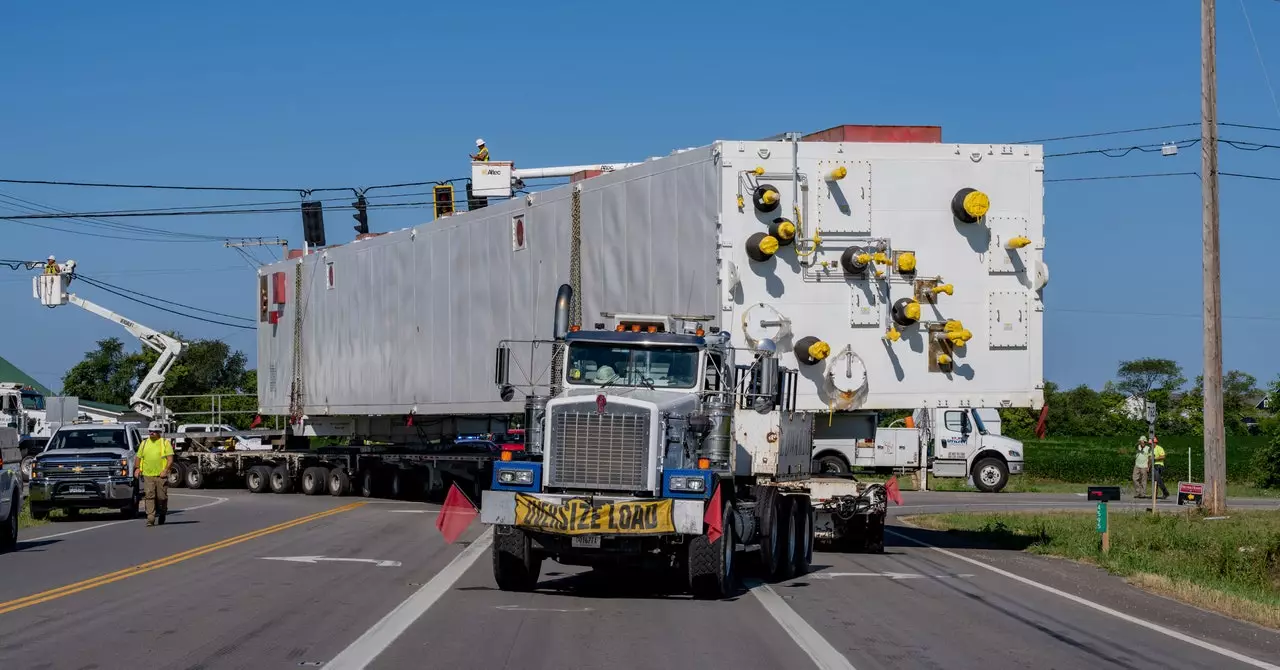In Ohio, a hulking leviathan makes its way through the landscape, a feat born from almost two years of meticulous preparation. These so-called “superloads,” which are exceptionally large cargo transports exceeding 120,000 pounds, are not just logistical challenges; they represent a critical component of infrastructure development for Intel. Amongst these colossal loads, number 13 stands out, measuring an astounding 280 feet in length and weighing nearly 1 million pounds. Despite its unassuming name, a cold box, this structure plays a significant role in the world of microchip manufacturing.
This gargantuan piece of equipment hails from Europe, having journeyed across the ocean to New Orleans before traversing the inland waterways of the Mississippi and Ohio rivers, landing at a specialized port designed for such oversized cargo. The shipment’s final leg—overland transit to the Intel site—demands a choreography of coordination from diverse stakeholders, including local authorities, utility companies, and the Department of Transportation.
Transporting this behemoth requires careful orchestration. An intricate web of logistics unfolds as various trucks come together to transport the cold box. The operation spans an entire week and necessitates an array of permits. Power lines and traffic signals along the route require physical adjustments, underscoring the disruption and complexity associated with moving such a significant load. In deference to the community, these oversized movements are scheduled outside of busy times, avoiding the start of the school year—a decision that reflects respect for local residents’ daily lives.
When observers first catch wind of the approaching cargo, it is heralded by a low yet ominous hum, a precursor to the visual spectacle soon to unfold. The cold box itself is a vital component of an air separation unit, designed to maintain a pristine environment for microchip production. Factories operating in this field must be devoid of any contaminants; even minor particles can play havoc on silicon wafers. The operation of this technology demonstrates Intel’s commitment not just to production capacity, but also to maintaining the highest manufacturing standards.
The route taken by the superload isn’t just a mere path—it’s a shared experience for many local residents, esteemed watchers of this logistic marvel. Enthusiasts track progress via social media, where updates from the Ohio Department of Transportation generate a mix of responses ranging from support to frustration. Some locals express excitement about the technical triumph of moving such an enormous load, while others lament the traffic disruptions it causes.
Among these onlookers is Emily Stone, affectionately dubbed the “Load Chaser” by her friends. Situated with her camp chair, she embodies the spirit of small-town America, where witnessing a superload is a notable event. Stone’s history in Portsmouth—an area once thriving with manufacturing—adds a layer of depth to her interest. The remnants of a bygone industrial age linger; factories that once produced shoes, steel, and bricks are now a memory. Local legacies, like Stone’s father’s, who worked in a plant formerly involved in uranium enrichment, underscore the community’s deep ties to industry and change.
While the arrival of the cold box represents technological advancement and economic opportunity, it also stirs complex emotions within the community. Emily Stone’s background reveals a history of contention between industry and its legacy, as she voices concerns demanding accountability from previous operators of the uranium plant that had detrimental effects on local health. The juxtaposition of progress against the backdrop of historical industrial practices prompts a broader discourse on corporate responsibility and environmental health.
In the context of the cold box’s transit and Intel’s ambitions, there lies both excitement for the future and trepidation about the lingering shadows of past industry. The confluence of these sentiments—pride in the community’s resilience, mixed with calls for accountability—highlights the dual nature of economic development. As Ohio embraces the challenges and triumphs of modernity, the journey of the superload stands as a metaphorical and literal representation of the community’s evolution, marrying hope with caution as they pave a path towards a new technological era.


Leave a Reply